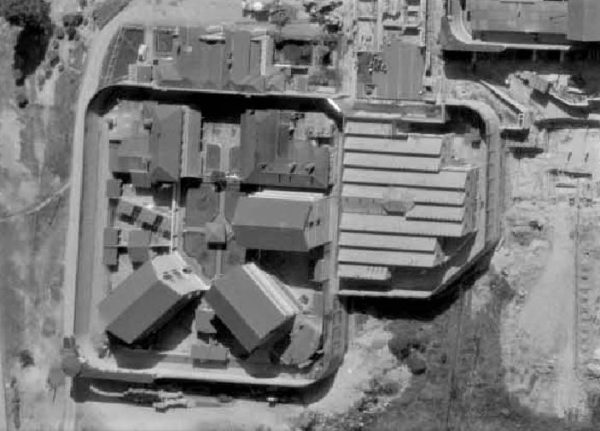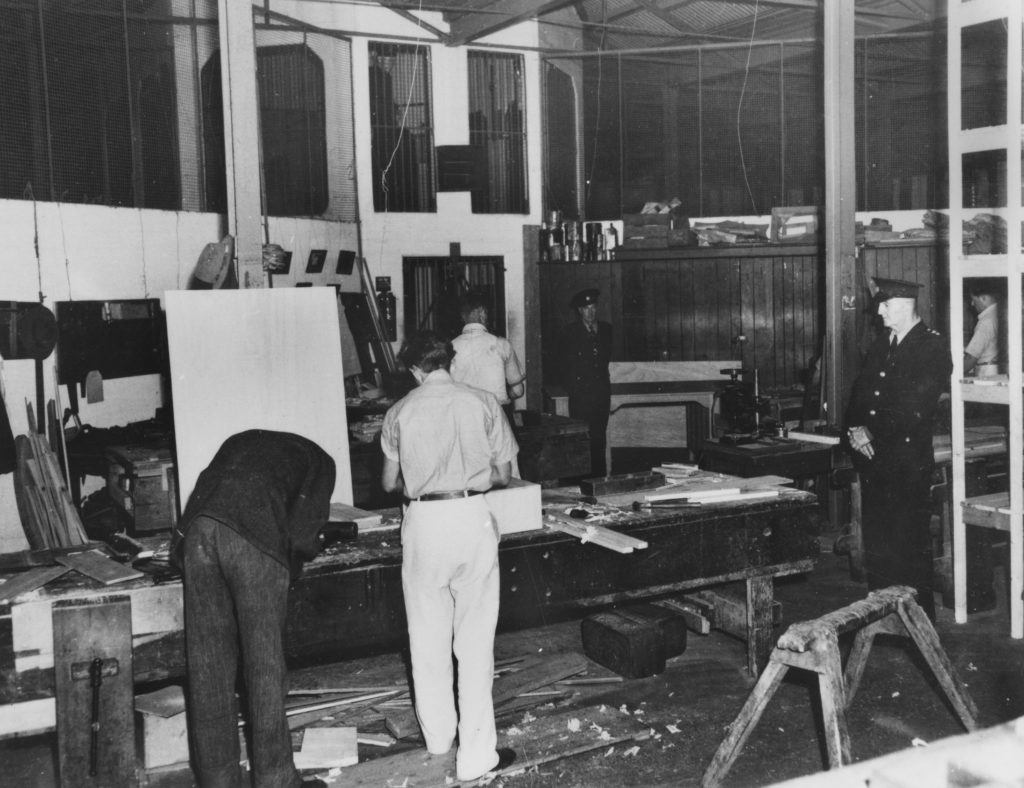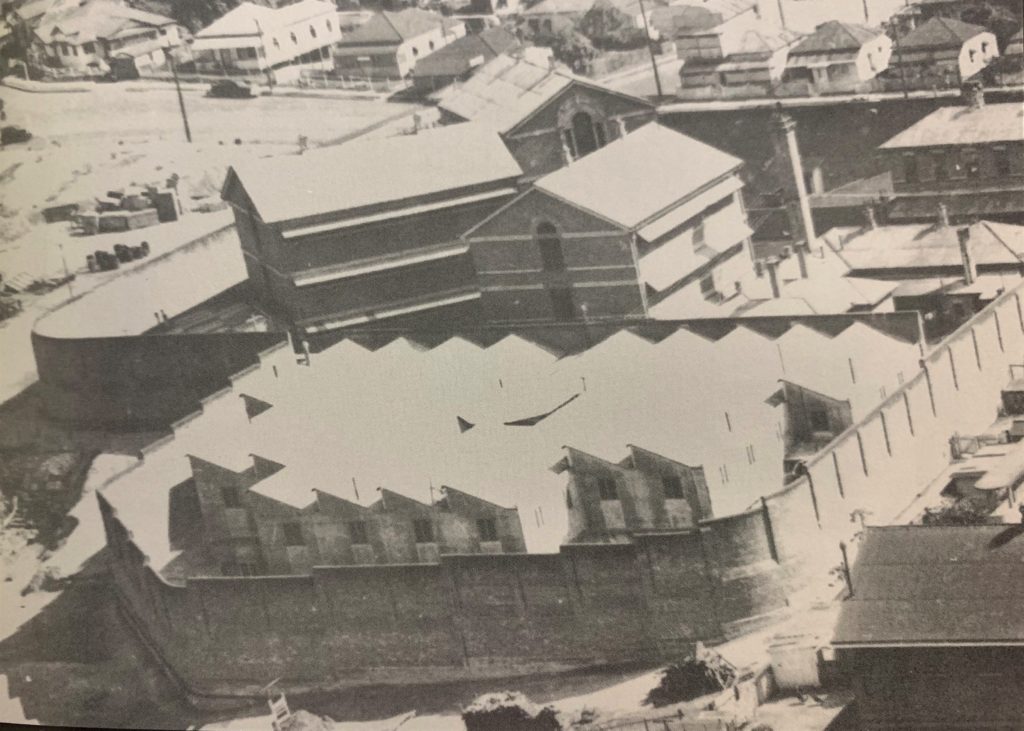The Colossus of Boggo Road
- On : 28 March, 2019
- By : Coordinator
- Category : Stories
- View : 4545
The Colossus of Boggo Road
Gold Coast bodybuilder Nathan Jones, at 207 centimeters and weighing 128 kilograms, was nicknamed “The Colossus of Boggo Road”.
The Colossus of Boggo Road in the movie “The Condemned”
Nathan was convicted in the Brisbane Supreme Court in April 1989 on five counts of attempted robbery and three of the unlawful use of a motor vehicle.
His eight-year sentence was increased to 12 years after an appeal by the Attorney-General.
In prison, an upset Nathan is said to have torn his cell door off; in reality he was a gentle giant.
Nathan was transferred when Brisbane Correctional Centre closed in 1992.
After serving his time, Nathan had a successful wrestling and movie career – including roles in blockbusters Troy, Mad Max: Fury Road, and horror films, Charlie’s Farm and The Condemned – filmed inside No.2 Division.
“TRIPOD” The Prison Cat
- On : 28 March, 2019
- By : Coordinator
- Category : Stories
- View : 3914
“TRIPOD” The Prison Cat
One of the last occupants of No.2 Division was “Tripod” – a much loved three-legged black tomcat.
“TRIPOD” the prison cat: photograph
taken 5th March 1988.
Source: Courier-Mail Library
His front left leg was badly broken during riots when it was caught in a cell door. Prisoners raised the money to have it amputated.
Prisoners jokingly referred to him as a “lifer” after 16 years of being in Boggo Road Gaol…
The Courier-Mail newspaper ran a story in March 1988 about Tripod:
“Most people consider black cats to be unlucky. But one group of people who have more reason than most to claim they are always down on their luck believe their black cat, Tripod is their good luck charm. Tripod is the mascot of the inmates of the notorious Division II wing of Brisbane Jail. Tripod, so named because he has only three legs, is jokingly referred to as a “lifer” around the jail as he has been there for 16 years.
He lost his left front leg when a cell door was slammed on it during a prison riot about 15 years ago. As a “registered” member of the prison establishment, Tripod gets his own ration of cat food each day before settling down in the main yard of Division II to keep an eye on things. When caught up with by photographer Graham Hutton, Tripod showed his displeasure at having his afternoon siesta disturbed by completely ignoring a visiting media group in the background.“
There has even been unconfirmed reports from some former prisoners that Tripod got a little angry towards the end of his life, and as a result, some prisoners put out a contract on Tripod’s life!
When his ‘9th life’ ran out Tripod was buried in a garden bed in No.2 Division where he remains to this day.
We have a special offer for these April, 2019 school holidays – all kids get a free Tripod the Boggo Road Cat poster with every family booking…
CLICK HERE TO BOOK FAMILY TICKET
(to get the poster, please make sure to select “Newsletter” when checking out under the “How did you find out about our tours?” question)
BOGGO S2 E9 – Workshops 90th Anniversary
- On : 28 March, 2019
- By : Boggo Road Gaol
- Category : Stories
- View : 2909
BOGGO S2 E9 – PRISON WORKSHOPS – The 90th Anniversary
With the closure of St Helena Island as a prison in Queensland came the shift of long service men to Boggo Road Gaol. What would now be the new number two division, the former prison for females would be moved elsewhere. The workshops for women were converted into the workshops for men. Soon however the need for the transfer of workshops from St Helena would necessitate the construction of an all new workshops at Boggo Road Gaol. 2019 marks the 90th Anniversary of these workshops.

After more than 50 years of operation, HM Prison St Helena would become a prison farm. Male prisoners classified as long term were transferred to the mainland to Boggo Road. Increasing costs to transport prisoners and supplies across Moreton Bay, and growing public resentment of a perceived “island paradise” being utilised by convicted felons, were behind the decision to wind down St Helena.
H.M Gaol Brisbane became H.M Prison Brisbane, more commonly called Brisbane Prison. To accommodate the changes on 21st September, Brisbane Prison was re-organised into three separate sections – No.1 Division, No. 2 Division and a Female Division.
No. 1 Division
The 1883 Men’s Gaol was renamed No.1 Division. The wording “BRISBANE PRISON NO. 1” was added to the parapet. Inside its walls there were few other changes. In practise it continued to be the section used to hold short-term sentenced male prisoners, and those on remand awaiting trial or sentence, just as it had for decades. The yards were used to separate prisoners according to their classification.
Female Division
In September 1921 the few female prisoners were transferred from their purpose built prison into two wooden communal wards surrounded by a tall timber stockade. The ward buildings – the former V.D. hospital from Brisbane General Hospital had been moved from the Brisbane Hospital and erected to the south of the former Women’s Prison on Annerley Road. Ironically, not even 20 years after the prison designed to prevent the evils of association opened, women were again housed communally. This would remain the women’s prison for the next 30 years.
No. 2 Division
The former Women’s Prison was empties of its occupants as prisoners from the Men’s Gaol set about making alterations in preparations for the arrival of new occupants – long term sentenced men from St. Helena including, murderers, killers and other dangerous offenders.
Officially renamed No. 2 Division, the words on the parapet were amended from “H.M. PRISON FOR WOMEN” to “H.M. PRISON FOR MEN” the letters “WO” neatly covered to indicate the new use. This alteration can still be seen today. Beneath these words “No.2” was painted. Inside the gatehouse, on the rear wall prisoners painted “B.P” for Brisbane Prison on the left hand side and “No.2” on the right.
The two female wards were reused as cell blocks for men with 40 cells available in each block, No.2 Division could hold up to 80 male prisoners.
The design of No. 2 Division – permitting single cell accommodation and prisoners and having yards to separate prisoners, would allow the separation of male prisoners according to their classification, which had proved difficult to administer on St. Helena. There, some men were kept in associated wards “herded” together; minor offenders missed with experienced criminal; Promiscuous association” – sexual predation and homosexuality – were serious offences at the time. At St. Helena, communal accommodation had led to sexual assaults. Authorities hoped that sexual liaisons and crime could be limited in No.2 Division by walls, iron bars and doors.
The Workshop for Men (1921 – 1929)
Central to the new prison system was providing prisoners with meaningful work.
Tailoring and boot making were transferred in 1921 from St Helena to the former female workshop in No. 2 Division; the facilities were upgraded. In April 1924, Tin-smithing was also transferred to No. 2 Division. As had been the case for decades, tailoring, boot-making and tin-smithing would be carried out under the supervision of trade instructors – warders with skills in these areas. Long-term prisoners would be well-suited to learn a trade as they had the time to become proficient and would leave with a usable skill. Short-term prisoners carried out work that required less skill- brush-making, mat-weaving and basket-making.
NEW WORKSHOPS AND TUNNEL (1929)
Until early 1929, male prisoners continued to be employed in the former women’s prison workshop in No.2 Division. On the 26th March a vast new saw-tooth roofed industrial complex opened, behind the eastern wall of the division. Encircling the “workshops” was a six metre high brick wall. A significant security feature was a central security tower – D Tower- manned by an armed officer. Mirrors high on the walls allowed the officer to see into every shop at all times. An underground tunnel – connecting No. 1 Division and No. 2 Division was built, allowing prisoners to be moved to and from the new workshop complex.
The workshops included a tailor shop – producing staff and prisoner uniform; boot shop – making boots worn by prisoners, mat-shop – making mats, mattresses ad hammocks; brush-shop – brushes and brooms; hat shop – hats worn by prisoners; bookbinding.
A new carpenter’s shop was dedicated to woodwork – to manufacture articles needed in government institutions such as schools. In May 1930 a new warder- carpenter was employed to teach that trade to prisoners.
After the opening of the new workshops the old female workshops was converted into an additional cell block to cope with the expected increase in prison population.
In this episode of BOGGO, Gaol Director Jack Sim and Research Coordinator discuss the Workshops, the cost of their construction and some of their interesting features as well as their crucial role in everyday prison life. Tune in to BOGGO the official podcast of Boggo Road Gaol to hear more.
You can stand in the former female workshops now D Wing cell block every day on our History Tour for tour times and prices visit www.boggoroadgaol.com




